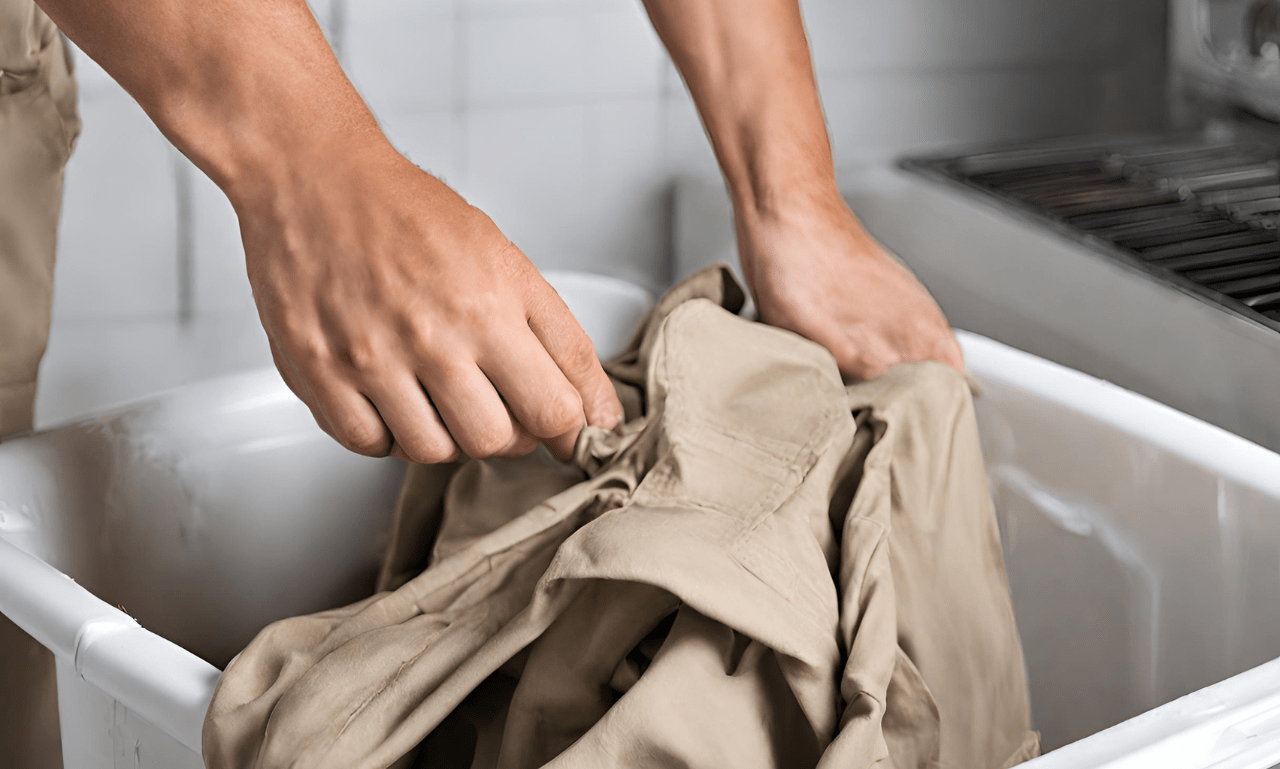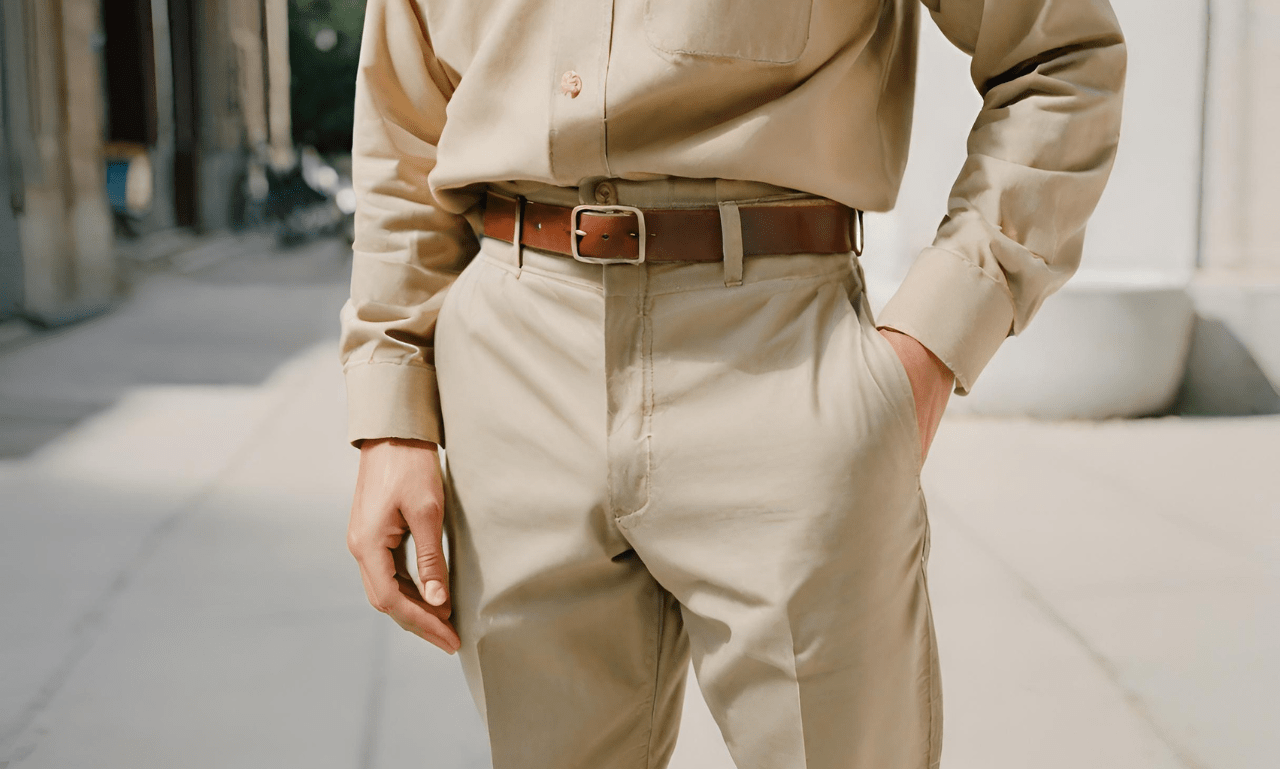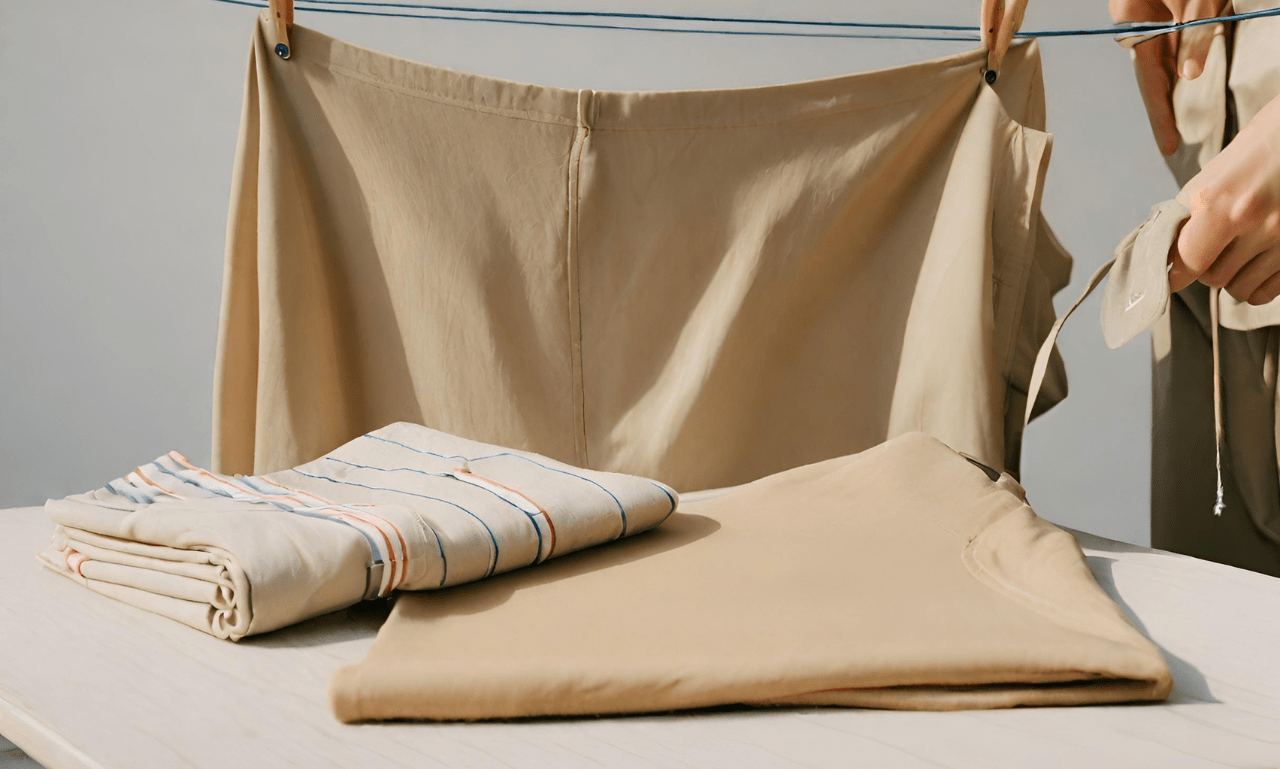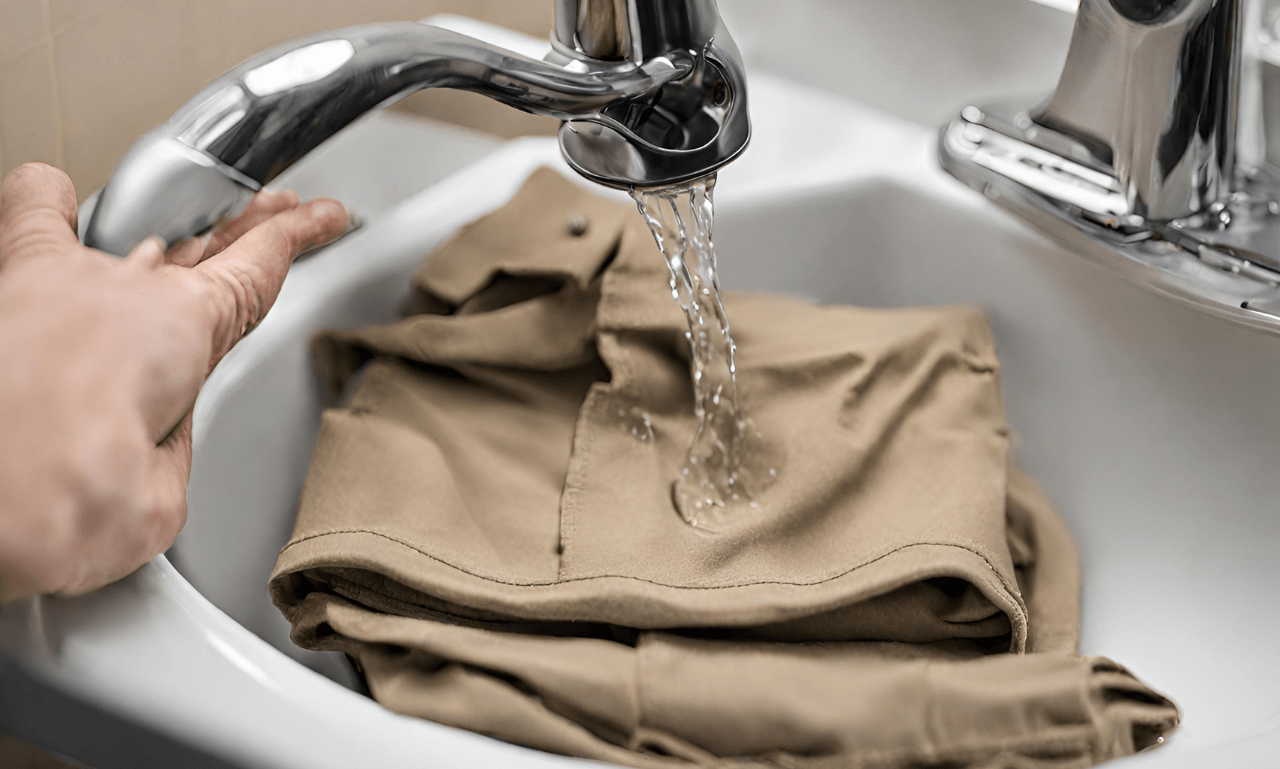Introduction
The Dilemma of Washing Khakis
Washing khakis can be a puzzling task. You might wonder whether they belong with your light-colored laundry or your darks. This guide is here to demystify the process and help you make the right choices to preserve your khaki garments.
Preserving the Color and Quality
Khakis are known for their classic style and versatility, but improper washing can dull their color and affect their quality. We’ll explore the steps you need to take to ensure that your khakis stay vibrant and last longer.

Understanding Khaki Fabric
What Makes Khaki Unique
Khaki fabric is distinctive due to its cotton twill weave and beige or tan color. Understanding the characteristics of khaki fabric is essential for proper care and maintenance.
Why Color Preservation Matters
The color of khakis is a defining feature, and preserving it is crucial for a polished appearance. We’ll discuss why color preservation is significant and how it impacts the overall look of your khakis.
The Origin of Khaki Fabric
Before we dive into the importance of color preservation, let’s take a moment to explore the origins of khaki fabric. The word “khaki” itself is derived from the Hindustani word “khākī,” which means “dust-colored.” Khaki fabric was originally developed by the British military in the mid-19th century for use in India. The goal was to create a uniform that would blend in with the dusty, arid landscapes of the Indian subcontinent.
Khaki fabric’s unique color and twill weave made it perfect for this purpose. The beige or tan hue helped soldiers remain inconspicuous in a variety of environments, from deserts to grasslands. Its cotton twill weave gave it durability and comfort, making it an ideal choice for long hours of wear in the field.
The Versatility of Khaki Fabric
Khaki fabric’s adaptability goes beyond military use. Today, it’s a staple in the fashion world, known for its versatility and timeless appeal. Whether you’re wearing khaki pants, shorts, a skirt, or a jacket, the neutral color pairs well with almost anything in your wardrobe. It’s equally at home in a casual outfit or a more formal ensemble, making it a favorite choice for business casual attire.
Why Color Preservation is Crucial
Now that we’ve explored the historical context and versatility of khaki fabric, let’s delve into why preserving its color is so crucial:
- Aesthetic Appeal: Khaki’s distinct beige or tan color is what sets it apart from other fabrics. Fading or discoloration can significantly diminish the visual appeal of your khakis, making them look worn out and shabby.
- Wardrobe Versatility:** Khaki clothing is often chosen for its ability to complement a wide range of colors. If the khaki color fades, it may limit your outfit options, as it may no longer pair well with other items in your wardrobe.
- Professionalism: In many professional settings, khakis are a go-to choice for a polished yet comfortable look. A well-preserved khaki color is essential to maintain a professional appearance.
- Economic Value: Khaki clothing is an investment, and proper care can extend its lifespan. Preserving the color ensures that your khakis remain in good condition for a longer time, saving you money in the long run.
How to Preserve Khaki Fabric Color
Now that we understand the importance of color preservation, let’s explore some tips on how to keep your khaki clothing looking fresh and vibrant:
- Wash with Care: Always follow the care instructions on the garment’s label. Use a gentle detergent, wash khakis inside out, and opt for cold water to prevent color fading.
- Avoid Sun Exposure: Extended exposure to direct sunlight can bleach khaki fabric. Hang your khakis in the shade or indoors to dry, and store them away from sunlight.
- Separate from Dark Colors: When doing laundry, separate your khakis from dark-colored clothing to prevent color transfer. This will help maintain the original khaki color.
- Use Fabric Softener Sparingly: While fabric softener can make clothing feel softer, excessive use can cause colors to fade. Use it in moderation.
- Consider Professional Cleaning: For valuable or delicate khaki items, consider professional dry cleaning to ensure color preservation.
By understanding the unique qualities of khaki fabric and taking steps to preserve its color, you can enjoy your khaki clothing for years to come, maintaining its timeless elegance and versatility in your wardrobe. In the following chapters, we will explore various aspects of caring for khaki fabric, from stain removal techniques to storage tips, to ensure your khakis always look their best.

Sorting Laundry for Khakis
The Importance of Sorting
Sorting your laundry is the crucial first step in ensuring the longevity and vibrant appearance of your khaki garments. Neglecting this step can lead to unsightly color bleeding, fabric damage, and the premature aging of your beloved khakis. In this chapter, we’ll delve into why sorting matters and how it helps preserve the quality of your khaki clothing.
Why Sorting Matters
Sorting your laundry may seem like a mundane chore, but it plays a vital role in maintaining the integrity of your khaki items. Here are some compelling reasons why sorting is essential:
- Preventing Color Bleeding: One of the most common laundry mishaps is color bleeding. When you mix garments of different colors in the same wash, especially if they’re new or have vibrant dyes, there’s a risk of colors transferring onto your khakis. This can result in unsightly stains or discoloration that is challenging to reverse.
- Avoiding Fabric Damage: Khakis are often made from delicate materials like cotton or cotton blends. Mixing them with heavier or coarser fabrics, such as denim or towels, can lead to friction during the washing and drying process. This friction can cause pilling, stretching, or even tears in your khaki clothing.
- Preserving Color Vibrancy: Khaki garments, with their earthy tones, look best when their colors are crisp and vibrant. Sorting ensures that they’re not exposed to harsh detergents, hot water, or rough treatment that can dull their appearance over time.
- Preventing Snags and Zippers: Zippers, hooks, and buttons on other clothing items can snag and damage your khakis if they’re thrown together in the same wash.
Grouping Khakis with Similar Colors
Now that you understand why sorting is so crucial, let’s explore how to effectively categorize your khakis with similar colors before doing the laundry. This step will safeguard your khakis from potential color transfer and keep them looking their best.
1. Separate Whites from Colors: The most basic sorting rule is to separate whites from colored garments. Since khakis often fall into the colored category, ensure they are not washed with white clothing, as any color bleeding will be more noticeable.
2. Sort by Color Intensity: Beyond just separating whites from colors, you can further refine your sorting process by grouping khakis with similar color intensities. For example, lighter khaki pants should be washed with other pastel or light-colored garments, while darker khakis can be grouped with darker-colored clothes.
3. Consider Material Type: Pay attention to the material of your khaki items. Some may be more delicate than others. For instance, khaki dress pants may require gentler treatment compared to casual khaki shorts. Separate them accordingly to prevent damage.
4. Check for Stains: Before tossing your khakis into the laundry pile, examine them for stains or spots. Treating stains beforehand can help prevent them from setting during the wash.
5. Empty Pockets: Always remember to empty the pockets of your khaki pants. Small items like coins, keys, or pens can damage the fabric during washing and may even create holes.
By diligently sorting your laundry and paying attention to these details, you’ll significantly reduce the risk of color bleeding and damage to your khaki garments. In the next chapter, we’ll dive into the essential steps for washing your khakis to ensure they stay clean and fresh without compromising their quality. So, stay tuned for more khaki care tips!

Washing Khakis Properly
Temperature and Detergent Recommendations
In the quest to keep your khakis looking fresh and vibrant, understanding the right temperature and detergent choices is crucial. Neglecting these factors can lead to unwanted color fading and a decrease in the overall quality of your khakis. So, let’s delve into the specifics of temperature and detergent recommendations to ensure your khakis stand the test of time.
Temperature Recommendations
- Cold Water is Key: When it comes to washing khakis, cold water is your best friend. Cold water helps preserve the color and fabric of your khakis, preventing them from fading prematurely. It’s also a more eco-friendly choice, as it saves energy compared to hot water washing.
- Occasional Warm Water Wash: While cold water should be your default choice, an occasional warm water wash can help remove stubborn stains or odors. However, make sure not to use hot water, as it can accelerate color fading and weaken the fabric over time.
- Avoid Extreme Temperatures: Extreme temperatures, whether hot or cold, should be avoided. They can cause the fabric to contract or expand excessively, leading to misshapen khakis and potential damage.
Detergent Recommendations
- Gentle, Color-Safe Detergent: Opt for a gentle, color-safe detergent specifically designed for delicates and colored clothing. These detergents are formulated to clean without causing color bleed or fading.
- Measure the Detergent: Overloading your washing machine with detergent can leave residue on your khakis and weaken the fabric. Always follow the manufacturer’s guidelines for detergent dosage. Using too much detergent is not only wasteful but also harmful to your khakis.
- Avoid Bleach and Harsh Chemicals: Steer clear of chlorine bleach and harsh chemicals when washing khakis. These can strip the color and weaken the fibers. If you need to tackle tough stains, consider using a stain remover designed for colored clothing.
Tips for Maintaining Color Vibrancy
Now that you know the right temperature and detergent choices, let’s explore additional tips for ensuring the vibrancy of your khakis remains intact:
- Turn Them Inside Out: Before tossing your khakis into the washing machine, turn them inside out. This simple step minimizes friction between the fabric’s outer surface and the washing machine drum, reducing the risk of color fading and pilling.
- Wash Similar Colors Together: To prevent color bleeding, always wash khakis with similar colors. Sorting your laundry into light, dark, and medium-toned loads can help preserve the integrity of your khaki pants.
- Use a Gentle Cycle: If your washing machine offers a gentle cycle option, use it when washing khakis. The gentle cycle is designed to minimize agitation, which is ideal for delicate fabrics like khakis.
- Don’t Overload the Machine: Overloading the washing machine can lead to inadequate cleaning and increased wear and tear on your khakis. Leave enough space for your pants to move freely within the drum.
- Skip the Dryer: Air drying is the best option for khakis. Hanging them on a line or laying them flat on a clean surface will prevent shrinkage, maintain the shape, and keep the color vibrant. If you must use a dryer, opt for a low-heat setting.
By following these temperature and detergent recommendations, along with the tips for maintaining color vibrancy, you can extend the life of your khakis and keep them looking as stylish as the day you bought them. In the next chapter, we’ll explore effective methods for ironing and storing your khakis to ensure they always look their best.

Special Care for New Khakis
Preventing Initial Color Bleed
New khakis can be prone to color bleed during the first few washes. Discover strategies to prevent this and keep your khakis looking fresh.
The First Few Washes
So, you’ve just purchased a crisp pair of khakis, and you’re excited to incorporate them into your wardrobe. Khakis are a versatile and timeless addition to any outfit, but they do require some special care, especially during their initial washes. In this chapter, we’ll guide you through the process of caring for new khakis, including how to wash them for the first time and ensure the color remains as intended.
Understanding the Color Bleed Issue
Color bleeding is a common problem with new khakis, particularly those made from cotton or cotton-blend materials. During the manufacturing process, excess dyes may not have been completely rinsed out, or the fabric may not have been properly set, causing the dye to release during the first few washes. This can result in faded khakis and potentially stain other clothing items in the wash.
Step 1: Sorting Your Laundry
To prevent color bleed, the first step is to sort your laundry properly. Separate your khakis from other clothing items, especially whites and light-colored garments. Washing khakis with darker items, even if they’re of the same color, can lead to dye transfer.
Step 2: Pre-Treating Stains
Before tossing your khakis in the washing machine, inspect them for any visible stains. Treat these stains with a stain remover or a mixture of water and mild detergent. Gently blot the stain and avoid scrubbing, as this can damage the fabric.
Step 3: Turn Your Khakis Inside Out
Turning your khakis inside out before washing them can help reduce friction between the fabric and the washing machine drum, minimizing color bleed and preventing excessive wear on the outer surface.
Step 4: Use Cold Water
When it’s time to wash your khakis, opt for cold water instead of hot or warm water. Cold water is less likely to cause the dye to bleed, helping to preserve the original color.
Step 5: Choose a Mild Detergent
Select a mild, color-safe detergent for your khakis. Avoid using harsh detergents that contain bleach or strong chemicals, as these can contribute to color fading and damage the fabric.
Step 6: Skip the Fabric Softener
Fabric softeners, while great for some garments, can be detrimental to khakis. They may break down the fabric and cause colors to fade. So, it’s best to skip the fabric softener when washing your khakis.
Step 7: Gentle Cycle and Minimal Agitation
Use the gentle cycle on your washing machine, and if possible, reduce the spin speed to minimize agitation. Aggressive washing can accelerate color bleeding and wear down the fabric prematurely.
Step 8: Air Dry
After the washing cycle is complete, resist the temptation to throw your khakis in the dryer. Instead, hang them up to air dry. The heat from the dryer can cause additional color fading and shrinkage. If you must use a dryer, choose the lowest heat setting and remove them promptly once dry.
Step 9: Iron with Care
If your khakis require ironing, do so on the reverse side while they are still slightly damp. This will help maintain their crisp appearance without damaging the color.
Step 10: Store Properly
Finally, when storing your khakis, make sure they are clean and completely dry. Avoid hanging them in direct sunlight, as prolonged exposure to sunlight can cause colors to fade over time.
By following these steps, you can ensure that your new khakis maintain their original color and quality, allowing you to enjoy them for years to come. Remember that with proper care, your khakis can continue to be a stylish and versatile addition to your wardrobe.

Drying and Ironing Tips
Drying Methods for Khakis
When it comes to maintaining the longevity and appearance of your khaki clothing, proper drying methods are just as crucial as washing. The way you dry your khakis can significantly affect their color and fabric quality. Let’s delve into some essential drying methods for khakis:
Air Drying:
– One of the gentlest methods to dry khakis is air drying. Simply hang your khaki pants on a clothesline or a drying rack in a shaded area, away from direct sunlight.
– This method helps prevent color fading, as prolonged exposure to sunlight can bleach the fabric over time.
– Additionally, air drying reduces the risk of shrinking or damaging the fibers, ensuring your khakis maintain their original size and shape.
Tumble Drying:
– If you’re in a hurry and need your khakis to dry quickly, using a tumble dryer on low to medium heat is an option.
– To protect the fabric, always turn your khakis inside out before placing them in the dryer. This minimizes friction between the fabric and the dryer’s drum.
– Be cautious not to overdry your khakis, as excessive heat can cause them to shrink or wrinkle. Remove them promptly once they’re slightly damp and hang them to finish air drying.
Dry Cleaning:
– For premium khaki garments or those with specific care instructions, dry cleaning is an excellent option.
– Professional dry cleaners use specialized equipment and techniques to clean and preserve the color and texture of your khakis.
Flat Drying:
– Lay your khakis flat on a clean, dry towel if you want to avoid any stretching or distortion of the fabric.
– This method is ideal for delicate khakis or those with creases you want to maintain.
Ironing Techniques for a Crisp Look
Now that you’ve learned how to dry your khakis effectively, let’s move on to ironing techniques to achieve that sharp, crisp look without compromising their quality:
Check the Fabric Care Label:
– Always start by checking the care label on your khakis for specific ironing instructions. Some fabrics may require a lower heat setting or steam ironing.
Adjust the Iron Temperature:
– Set your iron to the appropriate temperature for your khakis. Typically, a medium to medium-high setting works well for most khaki materials.
– Avoid using the highest heat setting to prevent scorching or burning the fabric.
Use a Pressing Cloth:
– To further protect your khakis from direct heat, place a clean pressing cloth (a thin cotton or muslin fabric) between the iron and the garment.
– Pressing cloths help distribute the heat evenly and prevent shine marks on the fabric.
Iron Inside Out:
– To avoid potential shine or iron marks on the outside of your khakis, iron them inside out. This also helps maintain the color and texture of the fabric.
Start with Lower Heat:
– If you’re uncertain about the right temperature, begin with a lower setting and gradually increase it until you achieve the desired results.
Steam Lightly:
– For stubborn wrinkles, use the steam function on your iron. Hold the iron a few inches away from the fabric and lightly steam the wrinkled areas.
Hang Immediately:
– Once you’ve finished ironing, hang your khakis on a sturdy hanger immediately to maintain their crispness. Avoid folding them immediately, as this can cause new wrinkles to form.
By following these drying and ironing tips, you can extend the life of your khakis and keep them looking sharp and fresh. Remember that proper care is key to preserving both the color and texture of your khaki clothing. In the next chapter, we’ll explore some advanced stain removal techniques to keep your khakis spotless and looking their best.
Conclusion
Keeping Your Khakis Looking Fresh
In conclusion, this comprehensive guide has equipped you with the knowledge and techniques to make informed decisions when washing your khakis. By understanding their unique characteristics and following proper care steps, you can ensure that your khakis always look fresh and maintain their original color.
Mastering the Art of Khaki Laundry
Mastering the art of khaki laundry not only preserves their color but also extends their lifespan. With these tips, you can confidently wash and care for your khaki garments, keeping them in top-notch condition for any occasion.
If you want to learn more about oven-safe dinnerware, check out our article on Can you Put Plates in the Oven? Oven-Safe Dinnerware Explained















